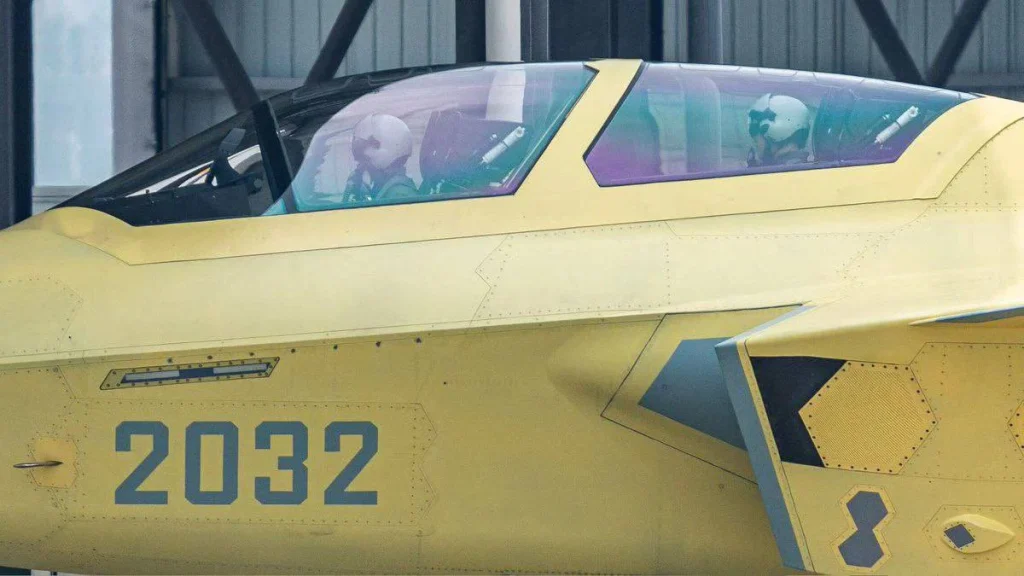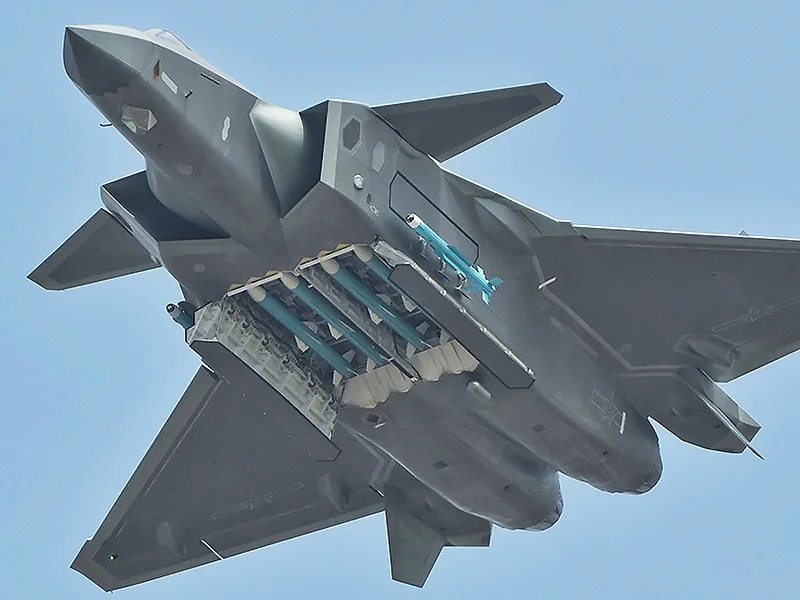
The J-20 entered service with the Chinese Air Force in 2017. A year later, Yang Wei, AVIC Corporation’s deputy director of science and technology, announced that this fighter would serve as the foundation for an entire family of combat aircraft. That winter, the corporation released a concept video featuring a two-seater J-20.
The first photos and videos of a two-seat J-20 taxiing appeared on the Weibo social network at the end of October. It differed from the standard version by having a longer cockpit canopy and being yellow coloured, typically associated with the primer.
In contrast, the Russians are developing a two-seat version of the Su-57 for exports and an unmanned version for domestic use. The same is true for the Su-75 Checkmate light stealth fighter.
The Dambiev Telegram channel published a video of the J-20 two seater version in testing in July 2022. The second prototype, tail number 2032, was photographed on an airfield. The new J-20 differed from the production aircraft because it had a two-seat cabin. The crew of a modernized fighter can include an armament operator.
It is believed that based on the J-20 two-seat modification, China can develop a ground attack version, a training vehicle and an electronic warfare aircraft (EW).
Chengdu Aircraft Industry Group (CAIG) J-20 Mighty Dragon fifth-generation multi-role fighter jet
On January 11, 2011, the single-seat Chinese fighter Chengdu J-20 took to the skies for the first time. It went into service in 2017. A two minute public debut of the J-20 took place at the opening of the Airshow China-2016 in Zhuhai, Guangdong Province. It is now used by China’s People’s Liberation Army Air Force (PLAAF).
In April 2017, a Chinese source Sina said that the PLAAF believes that “ideally”, the average annual production of J-20 fighters for the entire period of serial production should be 36 units. In the first three years, the production rate will be slightly more than 20 units; in the third to fifth years, the rate will be increased to more than 40 fighters annually. The total number planned for delivery to the PLAAF is unknown, but the experts believed it might be from 400 to 600 units. The plane started appearing in the airshows and parades in PLAAF colours, indicating that these aircraft had reached a high degree of combat readiness – “sword in the sheath”.
In November 2018, Shen Jinke, a spokesman for the PLAAF, told Xinhua News Agency that the fighters had passed the first combat tests. He specified that the tests were carried out over the ocean, and other fighters also took part in them, including the multi-role J-16 and the tactical J-10C.
Initially, the J-20 was based on the AL-31F series, which was to be replaced in the future by Chinese WS-15 engines in development. China bought 150 AL-31F engines (used on the Su-27 and Shenyang J-11 fighters) and 123 AL-31FN engines in 2011 (for the Chengdu J-10). Beijing and Moscow signed an agreement in 2012 to supply 140 AL-31F engines.
The Chinese Air Force presented the J-20 with PL-10 and PL-12 missiles for the first time on the final day of the China 2018 International Air Show in Zhuhai, with a couple of aircraft flying with the weapons compartment doors open. Four PL-12 medium-range missiles were placed in the central one (but some say it was the long-range PL-15 missile), and one PL-10 missile was placed on each side (only two on the plane). All these are air to air missiles.

J-20 fighters, according to publicly available information, can be outfitted with three different types of air-to-air missiles. The PL-10 is a Mach 4 short-range missile with a semi-active radar seeker. The warhead weighs 33 kg and has a range of about 50 kilometres. The second missile is a medium-range variant of the PL-12, with a top speed of Mach 4 and a range of about 90 kilometres. The third missile is the PL-15 long-range missile, which has a ramjet engine and can travel up to 300 kilometres at a speed of 4-5 metres per second.
Images of the J-20 outfitted with new engines surfaced on Chinese Internet forums in November 2019. Photographs released in late October show a J-20 painted in yellow primer flying and landing at the Chengdu-Huananba airfield, which is home to the CAIG plant (Chengdu). The new engine, whose precise designation has yet to be revealed, appears to be a variant of the Shenyang WS-10A Taihang and features serrated nozzle plates for stealth. On September 19, 2017, this engine variant was tested on the J-20 prototype numbered “2021” and then on the “2022” prototype in January 2018, after which the aircraft was transferred to the Chinese flight test facility at the Xi’an Yanliang air base.
In October 2020, a modernized version of the new generation J-20A, which differed from the basic version of the J-20, with the WS-15 engine and a nozzle design change, was revealed. The WS-15 is a turbojet engine capable of producing 14.5 tonnes of thrust at 1,400 degrees Celsius. Previously, it was reported that engines built in the PRC for fighter jets have a problem that results in a sharp decrease in thrust when the turbine reaches operating (temperature) parameters. According to Chinese experts, the problem was solved by “the use of new alloys.”

Following that, the J-20 was mass-produced with Russian engines. It was revealed that a newer model J-20B was equipped with an engine with a controlled thrust vector.
A J-20 fighter with Chinese WS-10C engines was displayed at the Zhuhai air show in 2021.
According to the Chinese Communist Party mouthpiece Global Times, Chengdu Aircraft Industrial Group Corporation announced in December 2021 the full-scale serial assembly of J-20 fighters following the start of deliveries of Chinese WS-10 engines.
The J-20’s technical specifications have not been made public. Its length is assumed to be 20.4 metres, its wingspan is 13.5 metres, and its maximum takeoff weight is 36.3 tonnes. The aircraft may have a top speed of 2,126 km/h.
J-20 is periodically attributed to the fourth, then to the fifth generation. The Chinese military themselves rank it among the fourth, but they count the generations by the time the aircraft was put into service and not by the characteristics of the fighter. And the J-20 has signs of a fifth-generation fighter, although this term itself is conditional and controversial, like the widespread use of stealth technologies.
